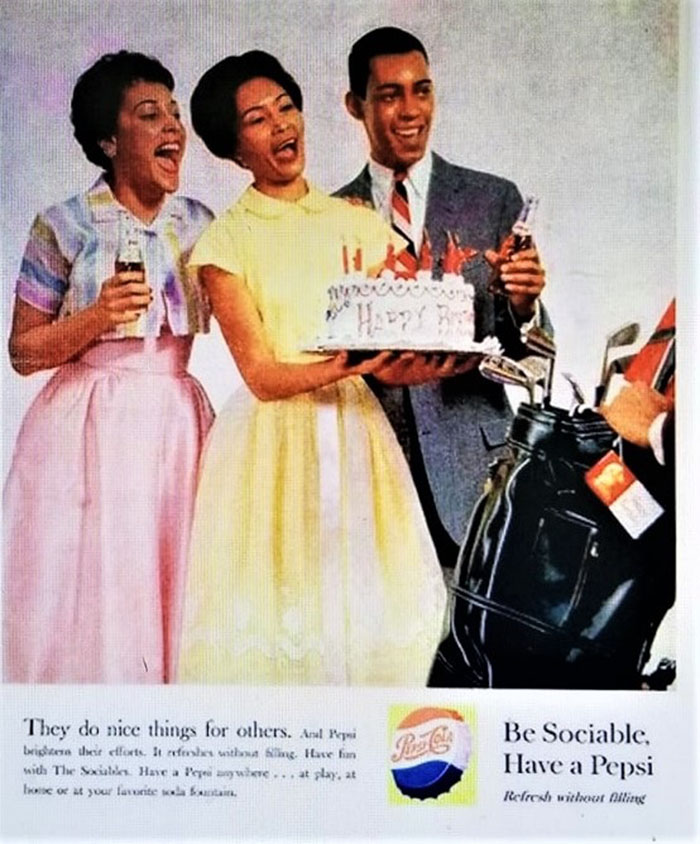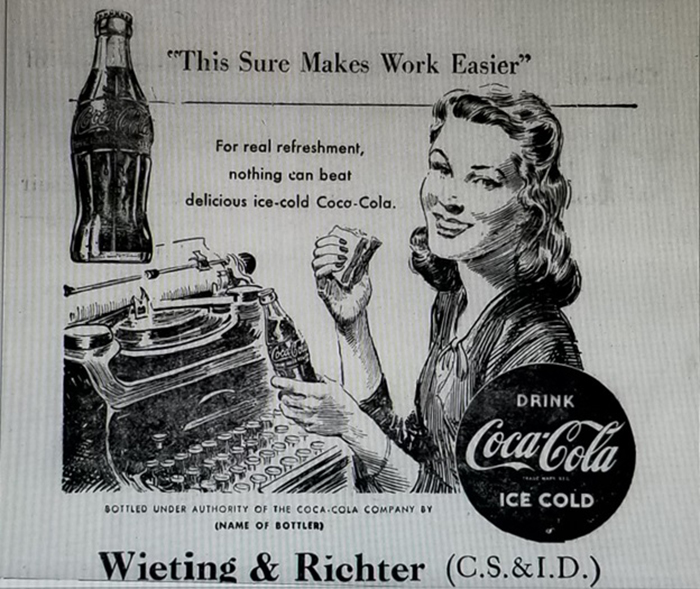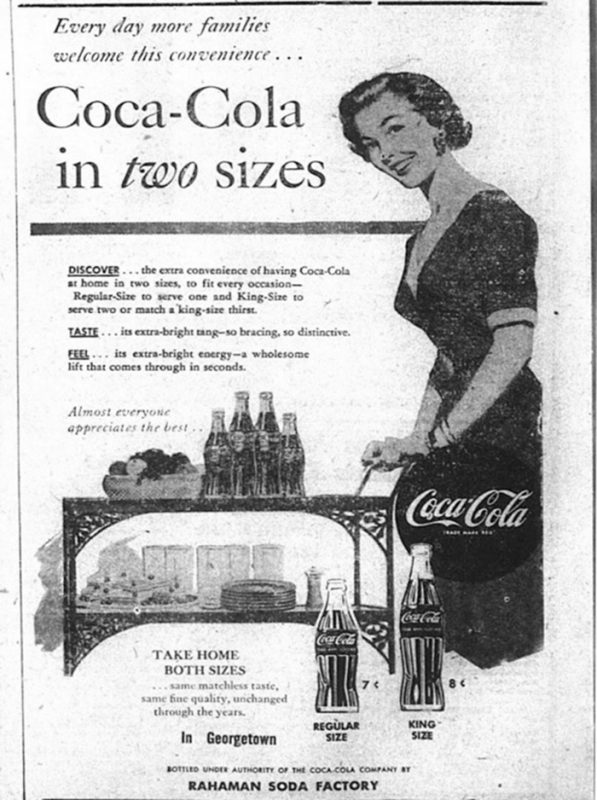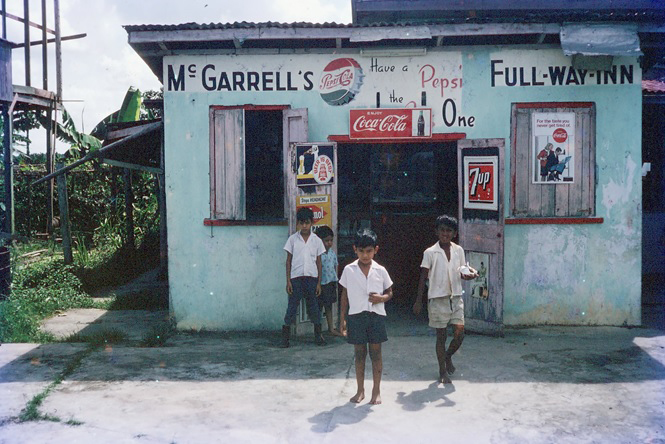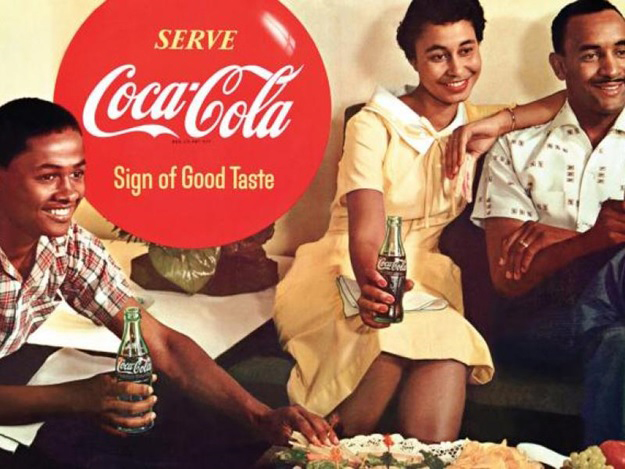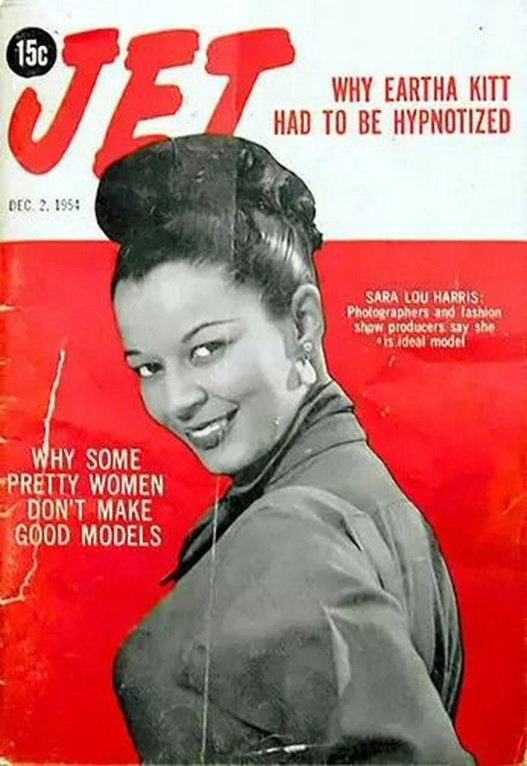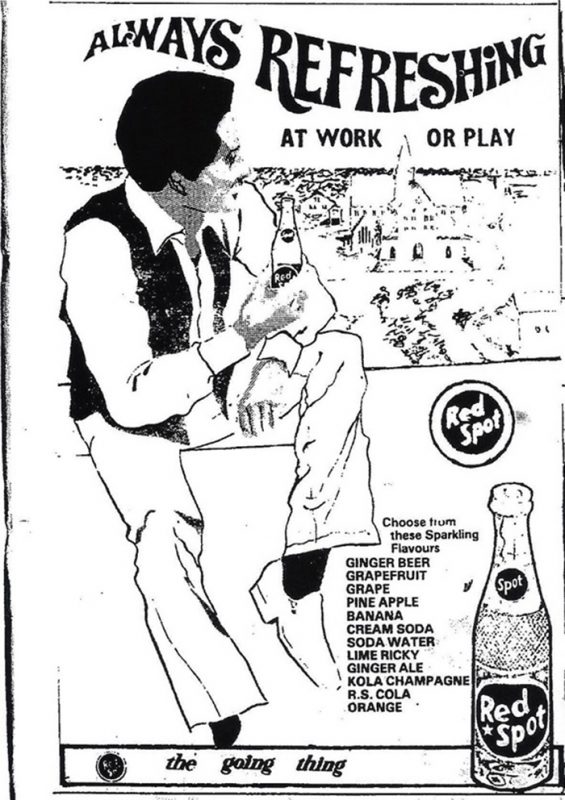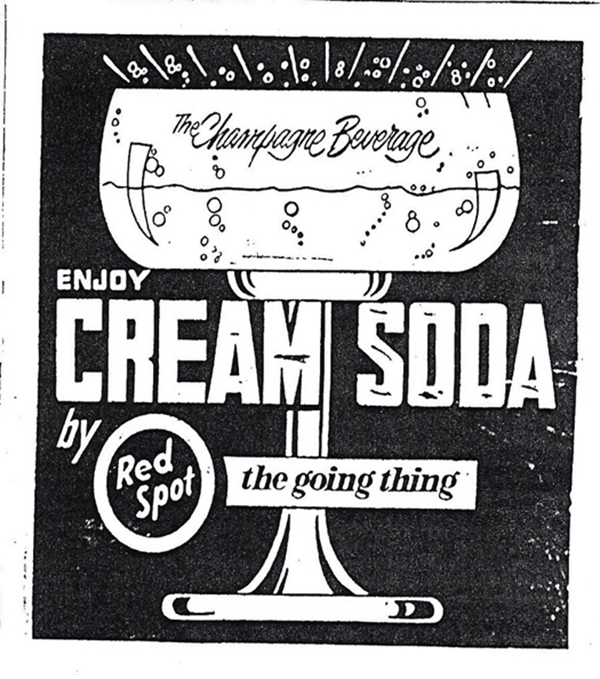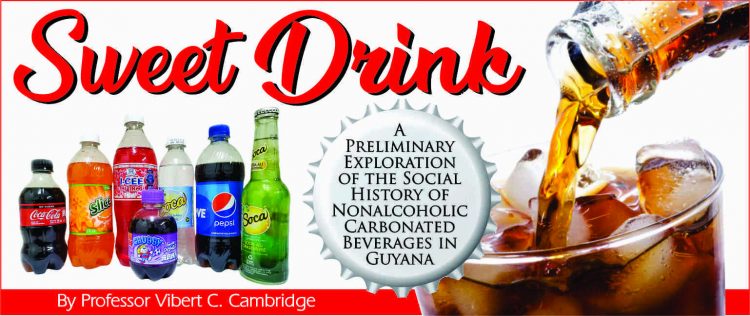
Most of the advertising used by Pepsi-Cola and Coca-Cola in British Guiana between the end of World War II and the 1960s was initially developed for the U.S. market. As the examples from the British Guianese newspapers of that era show, Pepsi-Cola and Coca-Cola’s newspaper advertisements were dominated by images of Caucasian women and men in comfortable post-World War II U.S. middle-class contexts. This represented the privileging of Caucasian norms of attractiveness, modernity, progress, leisure, and sophistication. When African American faces started to represent the Pepsi-Cola and Coca-Cola brands in the United States because of the civil rights struggle and efforts to increase market share, those changes were also evident in the advertising and marketing materials sent to the colony.
In addition to using newspaper advertisements, both brands included point-of-sale posters in their merchandising. Signs and posters were displayed inside and outside cake shops, groceries, and rum shops, which had replaced the “bub” shops as the primary deliverers of sweet drinks for on-site or take-home consumption. During the early 1960s, a popular Coca-Cola poster in retail establishments in Georgetown portrayed African Americans in a positive light. A family unit, comprising a seemingly contented mom, dad, and son, was shown relaxing in a comfortable setting, enjoying sumptuous sandwiches, and showing their “good taste” by drinking Coca-Cola. Hitherto, the dominant images of African Americans in U.S. consumer advertising were demeaning and dehumanizing caricatures and stereotypes, such as sambos, golliwogs, mammies, Uncle Ben, and Aunt Jemima.
The African American struggle for civil rights in the United States was coterminous with Guyana’s anti-colonial struggle. What happened to Black people in the United States was of interest to Black people in British Guiana. In the early 1950s, two important sources of information about the experiences, including the achievements and suffering, of Black folks in the United States were Ebony and Jet magazines. As was the case in the United States, readership was high in BG, and copies were kept and shared.
Starting in the 1950s, Pepsi-Cola, which was founded in North Carolina, began to target the African American market by placing advertisements in Ebony and Jet. As was the case with the Coca-Cola poster, the Pepsi-Cola advertisements in Ebony and Jet featured family units with a seemingly contented mom, dad, and their daughters relaxing in comfortable settings and being “sociable” with a Pepsi. The impact of these Pepsi advertisements on Guyanese consumer preferences for Pepsi or Coca-Cola is not yet known. Was PepsiCo aware of the potential to influence the tastes of Black people in the Americas when it started advertising in Ebony and Jet? One of the pioneering African American models in U.S. print advertising during this early period was North Carolina-born Sarah Lou Harris. She made the cover of Jet and Ebony magazines on many occasions. She was probably the first African American woman to be featured in a national advertising campaign in the United States. We will meet Sara Lou Harris again.
Unlike the situation with Pepsi-Cola and Coca-Cola, there do not seem to be any Red Spot advertisements produced by North American corporate headquarters. The Red Spot newspaper advertisements were produced by Guyanese advertising agencies, including Guyenterprise, which was founded by Vic Insanally and Clairmonte Taitt in 1966. Vic Insanally recently reflected on his company’s Red Spot account and the history of advertising in Guyana. He indicated that during the 1950s and 1960s, advertising was dominated by two agencies: Bookers’ Carib Advertising and Ace Advertising, operated by Vivian Lee. He stated, “The foreign firms Lonsdale Hands and Advertising & Publicity (Niall Willis) came with Independence.”
In addition, the state-operated Design & Graphics agency managed the extensive advertising and promotion requirements of the new nation state. The workers in these advertising agencies, including the copywriters, graphic artists, photographers, and campaign designers, were among the most creative individuals in the country. They helped the recently independent nation to nurture a post-colonial identity. From this sector came many of our contemporary beliefs, attitudes, and behaviors related to being Guyanese.
Working on the Red Spot account was exciting for Guyenterprise. It provided an opportunity to be novel, distinctive, and cost-effective. The agency’s designs were distinctive. Its body of work is a good representation of post-colonial Guyanese graphic arts, advertising, and marketing practices. A review of a collection of Red Spot newspaper advertisements created by Guyenterprise reveal the privileging of Guyanese monuments and urban fashion.
Underlying the advertisements was the decolonizing narrative of the early post-independence years. Some advertisements, such as the striking “The Champagne Beverage CREAM SODA,” were also used as cinema slides, a popular advertising platform when cinemas were central to leisure and entertainment. As Vic Insanally noted, “Cinema slides were very popular, with great audience reach and cheap.” Red Spot’s newspaper and cinema advertisements were complemented by the iconic enamel signs placed at cake shops, groceries, and other retail outlets.
Radio
By the end of World War II, radio had become an important mass communication medium in British Guiana. The establishment of Radio Demerara by the private British corporation Overseas Rediffusion Ltd. in 1950 brought a mode of operation that accommodated several influential environmental forces: the governor and the colonial administration, as well as the delivery of key audience segments to the commercial sector.
One of the characteristics of radio in pre- and post-World War II British Guiana has been the “brokerage system.” Individuals or companies purchase radio time to promote their own goods, services, or, in some cases, ideology. So, it was not strange to have spot advertising by companies (e.g., Wieting and Richter, D’Aguiar Imperial House) and programs (e.g., the Crown Rum Swizzle Dance Programme, the DeCastro Wine Programme, and Ovaltine Amateur Hour) that promoted specific products.
In 1952, DIH launched the “Cash In on Your Ideas Now!” radio promotion. This two-week promotion (Monday, September 15 to Tuesday, September 30) “offered BIG CASH PRIZES for the best IDEAS submitted, which may be used as radio programmes.” The competition rules were provided during a five-minute block (5:25 p.m. to 5:30 p.m.) Monday through Saturday on Radio Demerara. The first prize was BG$50, and the second prize was BG$25. There were six consolation prizes of one case of Pepsi-Cola each. The records pertaining to that radio promotion, its winners, and subsequent D’Aguiar Bros. Ltd. competitions and promotions were destroyed by fire. The reassembling of these details can be done through a careful study of the newspapers of the era. However, given the incomplete runs and lack of digitization of available collections, such a task is beyond the scope of this project, a preliminary exploration of the social history of sweet drinks.
By the early late 1950s, the Cola brands in British Guiana began to introduce new approaches, such as image advertising, which associates a product with the attractive attributes of an unrelated person, object, or concept. For example, the Coca-Cola bottle is evocative of the female body shape. So, it was not a stretch for the cola brands to associate their products with women. In 1958, both brands sponsored entrants in the Miss British Guiana Beauty Contest. In the next installment, we will explore this and other marketing and promotion tactics in the “war” for the Guyanese sweet-drink market.
SELECTED REFERENCES
Ciafone, A. Counter Cola: A Multinational History of the Global Corporation. Oakland: University of California Press, 2019.
Quigley, S. “The USO & Coca-Cola: A Refreshing 78-Year Relationship. USO, Tuesday, June 4, 2019. Available at https://www.uso.org/stories/155-the-uso-coca-cola-a-refreshing-75-year-partnership
Palmer, A. “Rum and Coca Cola: The United States in the British West Indies 1940–1945. The Americas. Vol. 43, No. 4 (April 1987), pp. 441–451.
Estes, A. “A Brief History of Racist Soft Drinks.” The Atlantic, January 13, 2013. Available online at https://www.theatlantic.com/national/archive/2013/01/brief-history-racist-soft-drinks/318929/?fbclid=IwAR1howsWl1EHC4b1WJDUPTqwm6K9O79P42cZ_mrxV83CAM-6GnkH_Xeskyw
